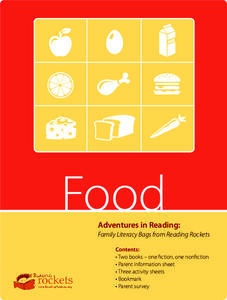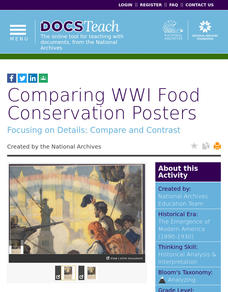Curated OER
Food Traditions: Making Cherokee Bean Bread
Imagine being forced out of your home and walking over 1,000 miles with only the things you could carry. How would you survive? What would you eat? After reading about the Trail of Tears and Cherokee resilience, middle schoolers are...
K20 LEARN
Speedy Cat: Enzymes
Enzymes have a need for speed! What happens when they are forced to slow down? A well-rounded lesson plan from the K20 Center examines enzyme activity through role playing and a lab. Biology scholars work in teams and pairs to understand...
DocsTeach
Uncle Sam and the American Diet
Uncle Sam wants you to follow the food pyramid! Scholars analyze two images of propaganda posters the government created to promote the food pyramid. Academics complete a worksheet to understand the impact of the campaign and end the...
PBS
Reading Adventure Pack: Cooking
A Reading Adventure Pack focuses on cooking. Scholars participate in three hands-on activities after reading the fiction book Easy as Pie by Cari Best and the nonfiction book How Did That Get in My Lunchbox? by Chris Butterworth....
PBS
Reading Adventure Pack: Food
An activity packet about food begins with reading two texts: Stone Soup by Marcia Brown or John Muth and Where Does Food Come From? by Shelley Rotner and Gary Goss. Learners then take part in three activities. They design a puzzle...
Nemours KidsHealth
Healthy Snacking: Grades K-2
Two lessons, all about snacking, look closely at how to make smart, balanced choices. Lesson one challenges pupils to create a menu for the hypothetical restaurant, The Snack Shack. Lesson two offers a variety of informative articles...
Nemours KidsHealth
School Lunch: Grades K-2
Two lessons encourage scholars to make smart eating choices. The first lesson sorts food items into the MyPlate's food groups. Learners scour magazines to cut and paste examples onto a paper plate that showcases each group. Then, draw...
Nemours KidsHealth
Food and Cooking Safety: Grades K-2
A cut and paste activity emphasizes the importance of safety precautions while cooking and baking. After reading several kid-friendly articles, class members cut 10 safety ingredients to paste on the pot's corresponding shape.
Nemours KidsHealth
Food and Cooking Safety: Grades 3-5
In lesson plan one, scholars read articles, brainstorm a list of tips, then vote on the most important ones. Using those tips, the class creates a mural detailing them with magazine cutouts. Lesson two challenges pupils to cook a dish at...
DocsTeach
Sequencing from Seeds to Harvest
Explore the farm to table experience in a fast-paced lesson on gardening. The activity uses image sequencing to help young scholars understand the process of growing food from seed to harvest. Academics also participate in group...
Nemours KidsHealth
Food Allergies: Grades 9-12
Imagine life without PB&J's! For some, it isn't a question of want but a question of life and death. High schoolers investigate food allergies and develop presentations that inform others about symptoms of allergic reactions...
Smithsonian Institution
Strength in Solidarity: Coalition of Immokalee Workers and the Campaign for Fair Food
Not all food is created equal. The lesson dives into the world of migrant farm workers to show their struggles to earn livable wages and better working conditions. Academics learn why the Coalition of Immokalee Workers was created and...
DocsTeach
Comparing WWI Food Conservation Posters
Food will win the war! At least, that is what some World War I-era posters say. Using two propaganda posters—one in English and one in Yiddish—young scholars consider why the Wilson administration had the posters created. Discussion...
Nemours KidsHealth
Food Safety: Grades 6-8
The flu or food poisoning? Middle schoolers learn how to safely prepare, cook, clean up, and store food with a instructional activity that has them first read articles about food safety. Partners create a video that shows them modeling...
Nemours KidsHealth
Healthy Snacking: Grades 6-8
Two activities focus on healthy snacking. In the first activity, scholars create a poster displaying two messages—pack a healthy snack and make good food choices. The second activity challenges pupils to draft a snack list and tag along...
Nemours KidsHealth
School Lunch: Grades 6-8
School lunches are the focus of two learning activities. Activity one challenges small groups to create a lunch menu for an imaginary cafe. Activity two sheds light on one's afternoon eating habits. Asking scholars to record what they...
Nemours KidsHealth
Food Labels: Grades 6-8
With the help of two activities, scholars discover what's in their favorite foods by reading nutrition labels. Activity one challenges participants to write a letter to a fictional peer about the importance of making healthy choices....
Nemours KidsHealth
Food Allergies: Grades 6-8
Over two lessons, scholars use articles and discussions to define what a food allergy is and identify the most common food allergens. Small groups prepare a skit showcasing how the body exhibits an allergic reaction. Learners examine...
Nemours KidsHealth
School Lunch: Grades 3-5
Two lessons encourage scholars to make smart food choices. Lesson one challenges participants to create a five-day meal plan. In lesson plan two, learners pack an imaginary lunch, drawing pictures on a printable lunch bag divided into...
Nemours KidsHealth
Breakfast: Grades 3-5
Two lessons promote starting the day with a balanced breakfast. Lesson one challenges scholars to create their own cereal after examining their current favorite cereal, including its nutrition facts. In lesson two, learners set their...
Nemours KidsHealth
Food Safety: Grades 9-12
Food poisoning, salmonellosis, E. Coli, shigellosis, tapeworms—all these words can strike fear into eaters. Alas, the five-second rule is not necessarily true! Two activities teach teens safety rules for food purchasing, preparation,...
Teach Engineering
Powering a Device Using Food
Eat up a resource on using food to power electrical devices. Future engineers first experiment with different fruits and vegetables to determine the amount of electrical energy they provide. Based on the data, they design and create an...
American Museum of Natural History
Journey to the Bottom of the Sea
Follow the path to the sea floor. Pupils play an online interactive board game to reach the bottom of the sea. Participants must match descriptions of creatures to a property of water dealing with oxygen, food, light, or density to move...
National Wildlife Federation
What's Your Habitat?
How do human habitats compare to animal habitats? Individuals begin their nature discovery by drawing their own habitats that extend beyond their houses. Pupils ensure their drawings include the four habitat elements of food, water,...

























